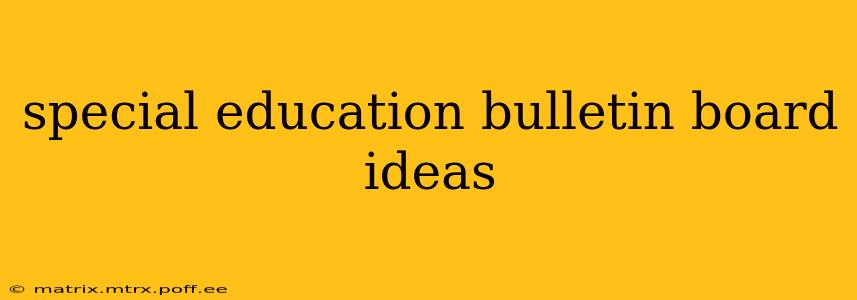Creating engaging and informative bulletin boards is crucial in a special education classroom. These displays not only brighten the space but also serve as valuable learning tools, reinforcing concepts and celebrating student achievements. This article explores creative and effective special education bulletin board ideas, addressing common questions educators might have.
What are some fun and engaging bulletin board ideas for a special education classroom?
The key to a successful bulletin board is to tailor it to your students' interests and learning levels. Consider themes that are relevant to your current curriculum or celebrate student accomplishments. Here are a few fun and engaging ideas:
- "Growth Mindset Garden": Students can "plant" their goals and track their progress, visually representing their growth and achievements. Use colorful paper flowers and leaves to create a vibrant display.
- "Our Amazing Class": Showcase student work, photos, and individual strengths. This board fosters a sense of community and celebrates the unique talents within your classroom.
- "Sensory Exploration": Incorporate different textures, colors, and materials into the bulletin board design itself. This can be particularly beneficial for students with sensory sensitivities or preferences. Use textured fabrics, natural elements, or even small manipulatives.
- Interactive Calendar: Create a large, visually appealing calendar that students can interact with. Mark important dates, upcoming events, and student birthdays. Use Velcro or magnets to make it easily adaptable.
- Skill-Based Displays: Focus on specific skills your students are working on, such as reading comprehension, math facts, or social skills. Use visuals and clear examples to reinforce learning. For example, a "Reading Rockets" board could track reading progress.
How can I create a bulletin board that is both visually appealing and accessible to all students?
Accessibility is paramount. Ensure your bulletin board design caters to diverse learning styles and needs:
- Visual Clarity: Use clear, concise labels and large, easily readable fonts.
- Color Contrast: Choose colors that provide sufficient contrast for students with visual impairments.
- Multi-Sensory Elements: Incorporate different textures and materials to engage multiple senses.
- Simplified Designs: Avoid overly cluttered designs that may be overwhelming for some students.
- Alternative Formats: Consider providing digital versions of the information displayed on the board.
What are some bulletin board ideas for students with autism spectrum disorder (ASD)?
For students with ASD, visual supports and predictable routines are crucial:
- Visual Schedules: Display a visual schedule of the day's activities directly on the bulletin board, helping students anticipate transitions.
- Social Stories: Create a visual representation of social situations and expectations, fostering improved social skills.
- Choice Boards: Offer students choices within structured activities, promoting autonomy and engagement. Display these options clearly on the board.
- Calm-Down Corner Visuals: Use the board to showcase visuals and strategies for managing anxiety and sensory overload, promoting self-regulation.
What are some bulletin board ideas related to specific learning disabilities?
Tailor your bulletin board to address specific learning challenges:
- Dyslexia: Use color-coded strategies, graphic organizers, and multi-sensory techniques to support reading and comprehension.
- ADHD: Employ visual timers, clear instructions, and a visually organized layout to reduce distractions and promote focus.
- Dysgraphia: Provide examples of neat handwriting, ergonomic writing tools, and assistive technologies.
How can I make my special education bulletin boards more interactive?
Interactive bulletin boards enhance engagement:
- Manipulatives: Include manipulatives that students can interact with, like Velcro pieces, magnetic letters, or small toys.
- Games: Integrate simple games or activities that reinforce learning concepts.
- Student Participation: Encourage students to contribute to the bulletin board by adding their work or ideas.
- Rotating Content: Change the content regularly to maintain student interest.
Remember, the most effective bulletin boards are those that directly support your curriculum, celebrate student accomplishments, and cater to the unique needs of your diverse learners. By incorporating these ideas and remaining adaptable to your students' specific requirements, you can create a welcoming and enriching classroom environment.
